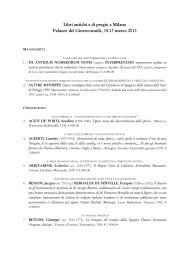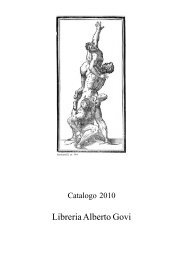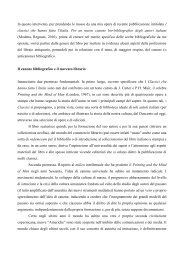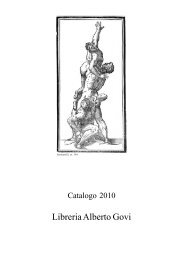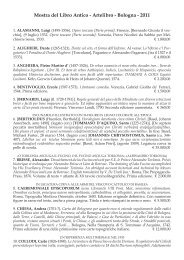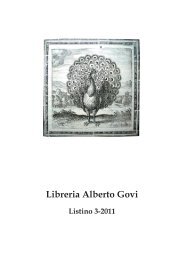The first important history of Trent and surrounding regions, including South Tyrol20) PINCIO, Giano Pirro (fl. 1 st half of the 16 th cent.). De gestis ducum Tridentinorum. De Gallorum Senonumaduentu in Italiam. De origine vrbis Tridentinae. De appellatione et transitu Alpium. De confinibus Italiae.Libri duo [Part 2, with separate title-page]: De vitis pont. Trid. libri duodecim: qui plura habent in recessuquam promittant in fronte: multa insuper externarum gentium facta domesticis addita sunt ut et plenior et iucundioresset historia. Mantova, Venturino Ruffinelli, 1546.Two parts in one volume, folio. 16, 104, (2 blank) ll. Contemporary limp vellum, outer corner of front panel skillfullyrepaired, short inscription on the first title page inked out, a genuine and attractive copy.RARE FIRST EDITION of the first printed importantchronicle of what today are the South Tyrol and Trentinoregions, especially under its prince bishops Georg Neideck(1505-1514), Bernardo Cles (1514-1539), and CristoforoMadruzzo (1539-1567). The work is dedicated to AliprandoCles, nephew of the bishop, and was translated into Italianby Carlo Zanetti in 1648 (cf. A. Chemelli, Trento e le sueStampe. Il Seicento, Trento, 1983, pp. 6-8).In June 1511 the two principalities of Trento andBrixen had received the status of “perpetual confederate”states among Austrian possessions. The peace of 1516 withthe Republic of Venice, however, reduced the principalityto a discontinuous enclave between large Habsburg possessions.During the war against Venice, in 1509, the territoryhad been ravaged by Landsknechts returning froma failed expedition against Vicenza. This was followed bypestilences in 1510 and 1512, famines in 1512, 1519 and1520, and an earthquake in 1521: these grievous happeningsspurred the beginning of forms of resistance againstHabsburg rule.A true rebellion broke out in 1525, called Bauernkriegor ‘peasants war’. The rebels were led by Michael Gaismayr,who had devised a complex plan of liberation ofall the territories of Brixen and Trento and program of socialfreedom based on equalitarian principles (Landesordnung).The rebels, however, lacked of organization andwere easily suppressed in 1526 by Austrian mercenariesand by the bishop Bernardo Cles, who exterminated themin the battles of the Eisack valley and Sterzing. The rebellionleaders were beheaded, hanged or mutilated, while thesimple followers were released but with a ‘mark of infamy’impressed on their brow. Any dream of further revolt endedwhen Gainsay was murdered in Padua in 1532. Some a thousand of Tyrolese and Trentine rebels took shelter inMoravia, were they established ‘fraternal farms’ (Bruderhöfe). Bishop Cardinal Bernado Cles thus is considered thetrue refounder of the authority of the princes of Trento.An adviser of emperor Maximilian I and a friend of Erasmus of Rotterdam, he played an important rolein the election of Emperor Charles V in 1519, and in that of his brother Ferdinand I as King of Bohemia in 1526. Hispersonal charisma reverted the subaltern status of the Trento state between the Habsburg territories, gaining theterritories of Castelbarco and Rovereto. His statute of the city, issued in 1528, remained in use until 1807. UnderCles’ rule Trento was renovated with a new urbanistic asset, and a new great church, S. Maria Maggiore: these wereneeded in order to host the important and influential Council of Trent (1545–63), and, after the sudden death ofCles in 1539, were completed by his successor, cardinal Cristorofo Madruzzo. Also the economy and services weregreatly improved. The presence of famous intellectual and scholars during the Council, spurred the diffusion of theRenaissance in the principality (cf. V. Krampera, I soggetti e la storia della Cronaca di Giano Pirro Pincio, Diss., Bologna,1984, passim; and P. Prodi, I personaggi e le scene, in: “Bernardo Clesio e il suo tempo”, Rome, 1987, I, pp. 14-20).“In generale, ogni scena significativa del libro è ripensata e descritta, più che con attenzione ai fatti e alleparole reali, sulla falsariga di un testo di riferimento. Così è sotto il segno di Macrobio (e Plinio, per la descrizionedelle inaudite meraviglie) l’opulenta raffinatezza del banchetto in Trento per la consacrazione del nuovo vescovo; ègiocato tutto sull’identificazione fra Cneo Pompeo e Carlo d’Asburgo, trasfigurando il secondo nel ‘summus imperator’del ciceroniano De imperio Cn. Pompeii, il discorso con il quale Clesio riesce a persuadere i principi elettoria favorire l’elezione di Carlo; Il discorso di Tullo Ostilio in Livio, 1, 28, dà le parole al prefetto Castellalto; Svetoniooffre importanti spunti per la descrizione delle abitudini di Clesio; ma, e sorprende di più, addirittura parlano conperiodi tratti dal De coniuratione Catilinae sallustiano i delegati dei contadini, con una forzatura che forse puòparere comica e che richiede allo stesso Pincio una curiosa precisazione relativamente a coloro che componevano lamissione, uomini ‘non sprovveduti grazie all’abitudine di trattare molti affari’ ” (B. Valtorta, Nota del traduttore, in:G.P. Pincio, “Vita di Bernardo Clesio”, Tricase, 2012, pp. III-IV).- 24 -
In Pincio’s biography of Bernardo Cles (Books VI-XII) are also described in great details the festivitiescelebrated during his installation as bishop of Trent: “Schon am Anlass der feierlichen Inthronisation von BernhardCles (8. September 1514) wurden prunkvolle Fest gefeiert, die uns Giano Pirro Pincio mit überschwenglicher Ausfühlichkeitbeschrieben hat. Unter den Unterhaltungen, welche vor und nach dem Festessen für den Adel und dievornehmsten Bürger veranstaltet waren, erwähnt der genannte Geschichtsschreiber Gesangsvorträge, Tonspiele,Tänze, Gedichte und Reden zum Lobe des Cles, und Spiele, welche zum Spott der Landbewohner in der Volksmundartaufgeführt wurden, und da die Festlichkeiten einige Tage fortdauerten, auch Possen und scherzhafteWortstreite. Es ist nicht unwahrscheinlich, dass damals auch das im Jahr 1482 zu Trient gedruckte Lustspiel ‘LaCatinia’ von Sicco Polentone aus Livico zur Aufführung kam. Unter den Hofnarren am Hofe des Fürstbischofs vonCles, welche die eingeladenen Gäste belustigten, befand sich sein Liebling, Ser Paolo, dessen in steingehauenes Bildman heute noch im Hofe des Stadthauses von Trient eingemauert sieht” (F. Demattio, Dialect und Dialectdichtung derItaliener in Tirol, in: “Die österreichische Monarchie in Wort und Bild”, Wien, 1893, pp. 336-367).Pincio also mentions the huge library created by Bernardo Cles: “È naturalmente a Bernardo Cles che spettail merito di aver dotato la residenza vescovile di una nuova e più ampia biblioteca: era un’imponente ‘libraria’,posta nell’ala destra del secondo piano del Magno Palazzo, compiuta architettonicamente nel 1535 e celebrata daumanisti come il mantovano Giano Pirro Pincio quale coronamento della ‘magnificentia’ della sua corte. La raccolta,che negli intenti del principe vescovo guardava ad un futuro lontano (edificata ‘ad nostrorum successorum, potiusquam ad nostrum commodum’), era il frutto dei suoi personali acquisti in terra tedesca degli anni precedenti,ma soprattutto della sua vasta rete di amici umanisti, ai quali aveva richiesto a più riprese consigli sul meglio dellaproduzione libraria disponibile sul mercato; così il 21 aprile 1533 scriveva al nunzio apostolico Girolamo Aleandroda Vienna per chiedergli un indice dei migliori autori in ogni campo del sapere. Il 5 gennaio 1534 da Praga scrivevaai controversisti Johannes Cochlaeus (1479-1552) e Johannes Eck (1486-1543) per informarli del progresso della sua‘fabrica’, sollecitando ancora di essere consigliato sulle migliori opere a stampa che fosse possibile acquistare inItalia e all’estero. Analogamente faceva con Erasmo, con il quale da anni era in rapporto epistolare; e nonostanteil legame cominciasse a raffreddarsi all’inizio degli anni Trenta, scriveva di aspettarsi da lui consigli preziosi e unelenco di libri ‘potiores’ ” (A. Paris, Dissenso religioso e libri proibiti nel principato vescovile di Tento tra fine Quattrocentoe inizio Seicento, Diss., Trent, 2011, pp. 19-20).The De appellatione et transitu Alpium is a kind topography of the Tyrolian Alps and a guide to the alpinepass routes. In it we find the first written reference to the Non Valley mentioning Lake Tovel as the source of thetasty char that one can fish in the lake (I. Franceschini, Uomini e risorse ambientali in Val di Tovel tra XVI e XIX secolo,in: “Studi tridentini di Scienze naturali”, Acta biologica, 81, 2004, Suppl. 2, p. 7-25).Little is known about Giano Pirro Pincio. He was born in Canneto (Mantua) and was active as a teacherof Latin and rhetoric, first at Mantua and then at Trento (1509-1536), where he also became court historian to cardinalBernardo Cles. In 1539 he was created poet laureat by emperor Charles V (cf. E. Franceschini, Breve discorsosull’umanesimo nel Trentino, in: “Aevum”, 35/3, 1961, p. 247).Edit 16, CNCE 29829; G. Nova, Stampatori, librai ed editori bresciani in Italia del ‘500, (Brescia, 2000), p. 90; B. Sanguanini,‘Dilettando educa’: attori, scene e pubblico nel mondo tridentino prima e dopo il Concilio di Tento, (Trent, 1989), p. 229;G. Tovazzi, Biblioteca tirolese, o sia, Memorie istoriche degli scrittori della Contea del Tirolo, R. Stenico & I. Franceschini,eds., (Trent, 2006), p. 569. € 4.500,00“the earliest historical and geographical dictionary” (J. Ferguson)21) GUGLIELMO DA PASTRENGO (ca. 1290-1362). De originibus rerum libellus.... In quo agitur de scripturisvirorum illustrium. De fundatoribus Vrbium. De primis rerum nominibus. De inuentoribus rerum. De primisdignitatibus. Deque magnificis institutionibus. Expurgatus omni errore atque litura, nunc primum è tenebriseductus in lucem, in suffragium studentium à Michaelangelo Blondo, solerti rerum exploratore. Venezia, NicolòBascarini per Michelangelo Biondo, 1547.8vo. 131 leaves, (1 blank). Contemporary vellum, on the verso of the title-page entry of ownership of ArcangeloAgostini (1660-1746), a Carmelitan friar known for his translation from the French of many historical and theologicalworks (cf. C. de Villiers, Bibliotheca Carmelitana, Roma, 1927, I, coll. 192-193); on the recto of the last blank leafentry of ownership of one Silvio Sabbatini, dated 1602; title-page lightly soiled, some minor foxing at the beginningand at the end of the volume, light marginal dampstains on a few leaves, but a nice, genuine copy with old marginalannotations.RARE FIRST EDITION of “the earliest historical and geographical dictionary” (J. Ferguson, Bibliographical Noteson Histories of Inventions and Books of Secrets, London, 1959, I.3, p. 6). The work basically falls into two parts: the firstis an alphabetical bio-bibliography of past writers (pagan and Christian), the second consists of six sections cataloguingthe origin of things, such as traditions, public offices, subjects of scholarly inquiries, regions of the world,inventors, the founders and origins of cities. Pastrengo often names his sources and did make a significant advanceon such treatment of inventions as one finds in Vincent of Beauvais or Giovanni da San Geminiano by undertakingthe re-assembly of scattered heurematographical sources and consulting a number of classical writers on discovery(cf. B.P. Copenhaver, The Historiography of Discovery in the Renaissance, in: “Journal of the Warburg and CourtauldInstitutes”, 41, 1978, pp. 209-211). Unlike other comparable works from this period, Pastrengo was less concernedwith moralizing that with establishing a reliable bibliographic repertorium of known authors, what makes himvaluable for an understanding of early Italian humanism. The repertorium demonstrates a genuine love of books- 25 -
- Page 1 and 2: Catalogue 2013Libreria Alberto Govi
- Page 3 and 4: Catalogue 2013Libreria Alberto Govi
- Page 5 and 6: an hitherto unknown philosophical m
- Page 7 and 8: ustica Lib. X., edited by Giorgio M
- Page 9 and 10: the end is furthermore printed the
- Page 11 and 12: without typographical data, but pro
- Page 13 and 14: Letteratura Italiana”, CXL, 1963,
- Page 15 and 16: as secondary only.The present two e
- Page 17 and 18: position as secretary at the court
- Page 19 and 20: From 1528 he was rector of the newl
- Page 21 and 22: famous personage was in high favor
- Page 23: Luigi Alamanni and Antonio Brucioli
- Page 27 and 28: Tempio della Fama; e così ne trass
- Page 29 and 30: power, and yet to make it possible
- Page 31 and 32: lini, Andrea Alciati, Lilio Gregori
- Page 33 and 34: phy in particular, was presented as
- Page 35 and 36: quale quello che lui auspicava, e l
- Page 37 and 38: After the flight of the Medici from
- Page 39 and 40: to learn from their own experience
- Page 41 and 42: with some manuscript compositions p
- Page 43 and 44: death sentence issued against him o
- Page 45 and 46: the key work to Della Casa’s thou
- Page 47 and 48: important ones along with those of
- Page 49 and 50: a heavily annotated copy44) HORATIU
- Page 51 and 52: solitudine (1545), but undoubtedly
- Page 53 and 54: provide less description of patholo
- Page 55 and 56: the most up-to-date scientific ency
- Page 57 and 58: (pp. 4-10) written by the author hi
- Page 59 and 60: successivi alla consapevolezza che
- Page 61 and 62: night [February 22]. Rarely does a
- Page 63 and 64: subjects, including Saint-Gelais’
- Page 65 and 66: Catherine de’ Medici, succeeded o
- Page 67 and 68: losofico ed allegorico delle Metamo
- Page 69 and 70: The act concerning primogeniture is
- Page 71 and 72: are not many in number but who are
- Page 73 and 74: the Camilletta, his first work, Gut
- Page 75 and 76:
selig, sich nit allein zu kunst geg
- Page 77 and 78:
dle, or low. There are, however, pr
- Page 79 and 80:
nity: ‘mercenaries should be done
- Page 81 and 82:
colò Sfondrati), to whom the Causa
- Page 83 and 84:
close of Semiramis’ career. Ninus
- Page 85 and 86:
e contenuti matematici in Henri de
- Page 87 and 88:
The first Hungarian dictionary - Cr
- Page 89 and 90:
& T. Kovács, Deutschlernen in den
- Page 91 and 92:
chitectura’ des Wenzel Dietterlin
- Page 93 and 94:
neo-Latin anthology devoted exclusi
- Page 95 and 96:
as De la puissance ecclésiastique
- Page 97 and 98:
colazione was not eaten first thing
- Page 99 and 100:
advanced both the technical and the
- Page 101 and 102:
di Giorgio Zorzi, ambasciatore in O
- Page 103 and 104:
the Misnah100) MISNAYOT MESUDAR NAS
- Page 105 and 106:
the task of taking part to the nego
- Page 107 and 108:
This is the only iconological work
- Page 109 and 110:
on that occasion, were described an
- Page 111 and 112:
millo Camilliani, Francesco’s son
- Page 113 and 114:
Blanchard, Correggio and Mignard, R
- Page 115 and 116:
di Cicerone d’ottime antiche stam
- Page 117 and 118:
Pietro Aretino125) MAZZUCHELLI, Gio
- Page 119 and 120:
music129) TESTORI, Carlo Giovanni (
- Page 121 and 122:
Vol. VIII (1773): pp. (6), 854 with
- Page 123 and 124:
Di Felice e Gregorio Fontana, 1905,
- Page 125 and 126:
Cicognara, no. 190 (“Nelle quattr
- Page 127 and 128:
mo: fonti, theorie, modelli, 1750-1
- Page 129 and 130:
commentary on the treaty on shabbat
- Page 131 and 132:
poet laureate of Austria, and he le
- Page 133 and 134:
geo-political situation of the regi
- Page 135 and 136:
ope collecting views and pictures o
- Page 137 and 138:
inc.), 100 numbered engraved plates
- Page 139 and 140:
a gift from Emperor Napoléon III t
- Page 141 and 142:
Ardène, no. 123Caprara, no. 103 Tr
- Page 143 and 144:
Speckle, no. 73 Besson, no. 60- 143



